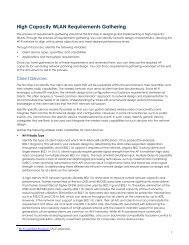You also want an ePaper? Increase the reach of your titles
YUMPU automatically turns print PDFs into web optimized ePapers that Google loves.
Introduction to wireless networking<br />
This chapter introduces some concepts you should understand before working with wireless networks, describes<br />
Fortinet’s wireless equipment, and then describes the factors you need to consider in planning deployment of a<br />
wireless network.<br />
<strong>Wireless</strong> concepts<br />
Security<br />
Authentication<br />
<strong>Wireless</strong> networking equipment<br />
Automatic Radio Resource Provisioning<br />
<strong>Wireless</strong> concepts<br />
<strong>Wireless</strong> networking is radio technology, subject to the same characteristics and limitations as the familiar audio<br />
and video radio communications. Various techniques are used to modulate the radio signal with a data stream.<br />
Bands and channels<br />
Depending on the wireless protocol selected, you have specific channels available to you, depending on what<br />
region of the world you are in.<br />
• IEEE 802.11b and g protocols provide up to 14 channels in the 2.400-2.500 GHz Industrial, Scientific and Medical<br />
(ISM) band.<br />
• IEEE 802.11a,n (5.150-5.250, 5.250-5.350, 5.725–5.875 GHz, up to 16 channels) in portions of Unlicensed<br />
National Information Infrastructure (U-NII) band<br />
Note that the width of these channels exceeds the spacing between the channels. This means that there is some<br />
overlap, creating the possibility of interference from adjacent channels, although less severe than interference on<br />
the same channel. Truly non-overlapping operation requires the use of every fourth or fifth channel, for example<br />
ISM channels 1, 6 and 11.<br />
The capabilities of your wireless clients is the deciding factor in your choice of wireless protocol. If your clients<br />
support it, 5GHz protocols have some advantages. The 5GHz band is less used than 2.4GHz and its shorter<br />
wavelengths have a shorter range and penetrate obstacles less. All of these factors mean less interference from<br />
other access points, including your own.<br />
When configuring your WAP, be sure to correctly select the Geography setting to ensure that you have access<br />
only to the channels permitted for WiFi use in your part of the world.<br />
For detailed information about the channel assignments for wireless networks for each supported wireless<br />
protocol, see Reference on page 158.<br />
22 <strong>Deploying</strong> <strong>Wireless</strong> <strong>Networks</strong> for <strong>FortiOS</strong> 5.4<br />
Fortinet Technologies Inc.



